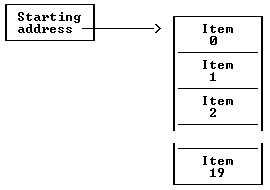When an array name is declared with a dimension in parentheses, memory space is set aside for the items that will be in the array. Memory space is also set aside for the name of the array, just like space is set aside for any variable name. However, the array name is automatically set up with the address in memory where the array items start. The only difference between an array name and an ordinary variable name is that the array name has a value automatically stored into it. This starting address points to the items in the array, and it is called a "pointer".
For example, the declaration
integer Account(20);
reserves memory space for 20 integers plus space for one more integer, the variable called Account. The variable called Account is set to point to the start of the space reserved for the 20 integers. Account is normally used with a subscript that refers to one of the items in the array. Account without a subscript refers to the starting address of the array. Here is what this array looks like:

The starting address of an array declared as "real" is handled as a real variable even though it contains a 16-bit address pointing to its data. The address is in the first two bytes, low byte first.
When an array is passed to a procedure, only the starting address is passed, not the actual items in the array. Thus an array passed to a procedure should never have its dimensions declared in the procedure. In other words, the local variable name of the array argument should never have parenthesis showing its size.
Memory used for arrays, as well as variables, comes from an area known as the "heap". The heap has about 60000 bytes and works like a stack but is a little more versatile. When a procedure returns, any arrays and variables that were declared in it are no longer needed. The heap space used by these arrays and variables is released so that it can be used by other arrays and variables in other procedures. This efficient method of using memory is called "dynamic memory allocation". The amount of unused space available in the heap can be determined by calling the Free intrinsic (18). If you have large arrays and need more space, see: 5.9 Segment Arrays.
Declared array dimensions must be constants; they cannot be variables. This is rarely a limitation because any constant expression can be used. For example:
def Size=20;
int Array(Size);
char Name(Size*3);
If a variable must be used to define the size of an array at run time, it can be done using the method described in: 5.4 Complex Data Structures.